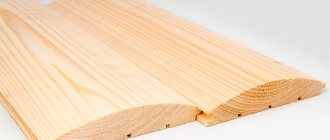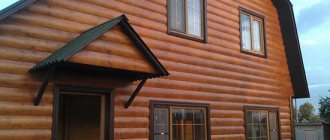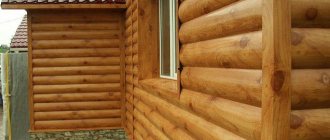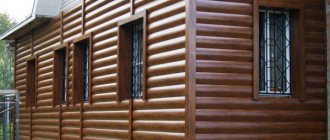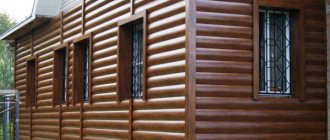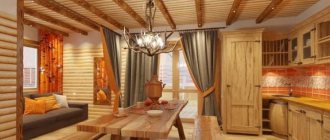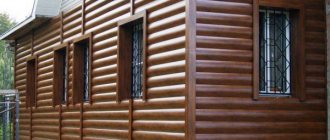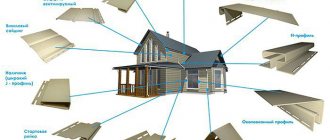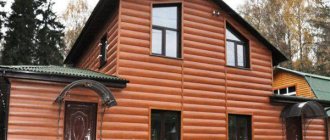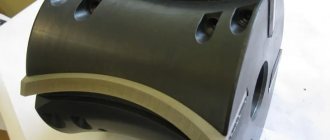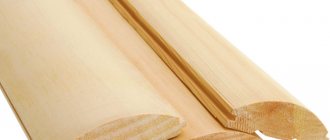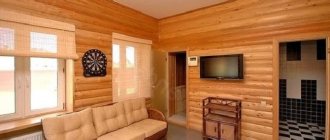Articles
All photos from the article
If individual developers know the dimensions of the block house, then calculating the amount of material for cladding the facade or interior spaces will not be difficult. The main parameters may vary slightly, so products must be selected taking into account the characteristics of a particular design.
The photo shows a standard panel.
Familiar dimensions
Each panel is a segment of a log, so after finishing activities the structure resembles a familiar log house. Coniferous wood species such as pine and spruce are usually used for production. However, production is not limited only to these raw materials.
Before you do the finishing with your own hands, you need to decide on the dimensions of the material. The special table below will help you familiarize yourself with the basic indicators.
| Main parameter | Value in millimeters |
| Length | 2000-6000 |
| Width | 90-190 |
| Thickness | 20-45 |
The most common dimensions.
Note! The width of the blockhouse and other parameters may exceed the specified values, since the table shows only the most common product sizes.
Colors
All types of siding from well-known manufacturers are presented on the market in a wide variety of colors. Manufacturers offer siding finishes that imitate any type of wood. If desired, you can decorate the building as a frame made of golden oak, dark walnut or, for example, pistachio wood. Possibility to choose cladding colors that do not exist in nature. However, panels made of well-recognized common wood - cherry, sandalwood, stained oak, walnut - are more often used.
It is worth noting that the decorative layer that gives the siding the appearance of a wooden beam or log will fade over time. Dark wood panels lose their original color especially quickly. Therefore, builders recommend using light-colored cladding. If the style of the house and the design of the site involve finishing the facades in dark colors, you need to purchase siding from well-known, reliable manufacturers. It will cost more, but will last much longer without restoration. It is worth taking into account the color fading factor at the stage of choosing the type of siding. Acrylic material will retain color intensity longer than vinyl. The branded metal siding will not lose its brightness for a long time. Wood material will burn out faster than other analogues.
Helpful information
When choosing width, length and thickness, it is necessary to take into account some nuances that may affect the aesthetic perception of the finishing coating and other characteristics. Therefore, when purchasing material, it is important to take into account all the basic parameters.
If you choose the wrong length of the elements, there may be a joint in some part, which will worsen the appearance of the cladding. Sometimes too large pieces of material may remain, which will lead to unnecessary waste.
A wide house block is more suitable for covering the walls of tall buildings, as it visually narrows them. Narrow panels look ideal in small rooms with low ceilings.
An example of interior decoration.
As for the thickness, it allows you to make the surface more prominent, which means you should not neglect this parameter. Most often, massive elements are used in spacious rooms.
Material Specifications
Block House panels The technology of house cladding with Block House involves insulation and waterproofing of walls, plinths and gables of houses built from a variety of materials (brick, wood, reinforced concrete and stone). The advantages of cladding a house with Block House include the following facts:
- Easy and quick installation, which can be done with your own hands;
- Magnificent appearance of finishing;
- Possibility of additional insulation and waterproofing of walls;
- Durability and strength of cladding;
- Availability of façade ventilation;
- Environmental friendliness and safety of finishing materials;
- Covering gables with Blockhouse allows you to organize high-quality ventilation and insulation of the attic space;
- The material does not lose color for a long time and does not fade in the sun;
- This type of finish is resistant to adverse weather conditions;
- The material is resistant to temperature changes and can be used in regions with low winter temperatures.
To know how to properly sheathe a house with Block House, let’s consider the disadvantages of the material, which, unfortunately, also exist, including the following properties of Block House:
- Block House made of wood is a flammable material. But today, manufacturers treat wood with special fire-resistant impregnations, which significantly reduces the likelihood of fire;
- Natural wood cladding requires constant maintenance. Treatment with disinfectant impregnations, cleaning and painting with special water-repellent primers;
- Metal siding Block House, as required by the installation instructions, must be installed with a layer of insulation, since the thermal conductivity of metal is very high.
Installation Features of a Block House Installation of a layer of heat and waterproofing when facing a Block House This type of cladding can be installed on surfaces made of a variety of materials - stone, brick, wood. Before sheathing a house with Blockhouse, you must first prepare the surface of the walls and base. And also cladding made of different materials has its own characteristics of installation work.
Preparing walls for the installation of a Block House
Installing waterproofing on a wooden sheathing before cladding The walls of the house must be smooth, without potholes or chips. This is necessary because in bad weather moisture can get into the cracks and, freezing, destroy the surface of the wall. Therefore, all irregularities and potholes must be plastered with cement mortar. Before sheathing the walls of a wooden house with Blockhouse, they must be treated with a deep-penetrating antiseptic primer and cleaned of mold. Before installing the cladding, it is a good idea to cover all wooden surfaces with drying oil, which will prevent the wood from rotting under the cladding.
Installation of a wooden Block House
Cladding with a wooden Block HouseInstallation work on the external cladding of the house with wooden panels should be carried out in the following sequence:
- First, you need to insulate the surface of the walls from moisture. Wooden walls are treated with a moisture-repellent primer, and brick and concrete walls are covered with a layer of special waterproofing film.
- Next, a sheathing is installed to fasten the cladding strips in increments of fifty centimeters, strictly vertically. The correct installation of the guides is checked using a level, plumb line and square.
- Cladding a Block House made of wood involves drilling holes for fastening in the boards of the facing material;
- The cladding is done using galvanized self-tapping screws. After installation, the screw caps are filled with special waterproof glue or decorated with special overlays sold along with the material.
- The locking grooves of the wooden Block House make it possible to quickly complete the façade cladding.
Installation of vinyl "Block House"
Finishing the facade with a vinyl Block House How to cover a house with a Block House with your own hands, without the help of specialists? The Vinyl Block House is mounted on a special sheathing installed strictly vertically. Fasteners and all necessary accessories for installation are usually sold along with the material.
On the Internet you can find video materials with step-by-step instructions for installing a vinyl Block House. Studying them will greatly simplify the installation of the cladding.
Installation of a metal Block House
Installation of a metal Block House A metal Block House is mounted on special galvanized mounting profiles, which are fixed to the walls with brackets.
Some calculations
Before finishing work, you have to find out how much blockhouse is in a cube. This measure of volume has taken root in the lumber sales industry. The following are basic calculations that will help you calculate the amount of cladding in squares and units.
Number of pieces per cubic meter
Sometimes it is necessary to determine how many pieces are in a cube: a block house may be required in a small volume. Then you need to make simple calculations to understand what part of a unit of volume the elements will occupy.
In addition, such calculations will help avoid fraud.
Formula for finding the volume of a parallelepiped.
- First you need to determine the volume of one panel. In our case, calculations will be carried out for a plank 6 m long, 19 cm wide and 30 mm thick. All parameters must be converted directly to meters. Thus, the following will be obtained: 0.19*0.03*6=0.0342 cubic meters. m;
- To understand how many blockhouse boards are in 1 cubic meter, you need to divide the unit by the result obtained. Thanks to this mathematical operation, it will be possible to obtain a final answer that can be rounded. An example would be: 1/0.0342≈29 pieces.
Important! The price of the presented material is quite high, especially when it comes to high grades of products, so proper calculations can prevent deception on the part of sellers.
Number of squares in a cube
When calculating the material, the total finishing area is determined, so you need to know the number of squares contained in a cubic meter. Then calculating the total volume of production for finishing work will not be difficult.
First you should decide on the thickness of the elements, since the number of squares per cubic meter will depend on this. The cubic unit is then divided by the selected panel section.
The thickness of the panels is taken as a basis.
For example, if you plan to purchase planks 45 mm thick, then you get the following expression: 1/0.045≈22 sq.m. When making calculations, millimeters must be converted to meters.
Appendix to the section
In order not to make independent calculations, it is suggested to look at the ready-made results for some standard product sizes. The results are reflected in a special table: how much space a block house takes in a cube, depending on different dimensions. When compiling, the emphasis was placed primarily on popular products.
| House block size in millimeters | Number of units per cube |
| 20x90x6000 | 92,5 |
| 30x140x6000 | 39,6 |
| 36x190x6000 | 24,3 |
| 30x140x2000 | 119 |
| 36x190x2000 | 73 |
Attention! When purchasing material, you should take into account the percentage of humidity. It should be 10-12 percent. Increasing the performance may negatively affect the quality of the finish.
How to correctly calculate the number of block houses?
Finishing the facade of a house with natural materials has become a fashionable trend these days. In particular, a block house is often used for these purposes. The material has an attractive appearance, it transforms the building and improves the performance characteristics of the house; the inside becomes warmer and more comfortable.
The block house imitates the texture and color of rounded logs. It itself is made from natural wood. Thanks to high-quality wood processing, the block house remains resistant to precipitation, temperature changes and the effects of microorganisms. The material is suitable not only for external but also for interior decoration. A block house is a great option if you want to decorate your home in a country style.
Before you start decorating your house with a block house, you need to buy the right amount of material and not make a mistake with its type.
Types of block house
Like many lumber, block house is divided into several grades: Extra, A, B and C. The higher the grade, the fewer knots, cracks, stains and other defects the wood will have. The panels also differ in size. Thus, the working area of one unit of material can be 4.05 m2, 3.24 m2, 3.33 m2. The panels also differ in thickness: 28 or 37 mm. Width and length of material: 135 mm by 6 m, 185 mm by 6 m.
In fact, the material parameters may differ slightly, which is important to take into account when making calculations. That’s why it’s best to check the panel sizes with the manufacturer in advance.
Having chosen the type and size of the material, it is easy to calculate the required number of boards.
Which panels are best to choose largely depends on the location of their installation. Thus, the most popular type of block house for interior decoration is panels 6 m long and dimensions 96x20 mm. The advantages of this type are that they do not “steal” the usable space of the room.
If you want to decorate a loggia, balcony, veranda, gazebo or terrace using a block house, pay attention to boards with a width of 140-190 mm. Such panels are ideal for external cladding
And although the color of the material does not affect the result of the calculations, it is impossible not to pay attention to this parameter when choosing panels. The block house is presented in a huge color palette. All colors and textures are natural and unique, like nature itself. For example, larch panels have about 12 shades. Boards can be coated with varnish or paint.
Calculation of material quantity
Since the volume of the sheathed surface is measured in square meters, calculations will be made in this unit of measurement. If the seller sells the block house in cubic meters, it is necessary to convert them into square meters.
The first thing to do is determine the area of the surface to be sheathed. To simplify calculations, you can conditionally divide the façade or room into separate planes and calculate the area of each of them. This is done simply - the height is multiplied by the width. If the walls have window or door openings or part of the wall is covered, for example, by a fireplace, you need to calculate their area and subtract it from the result.
Popular articles Wallpaper design 2022: top 200 photos of the best new products. instructions on how to choose and combine wallpaper by color and style
Important nuances when calculating a block house
During the process of facing work, there will inevitably be waste, so the block house must be purchased with a reserve. If you buy high-quality material, it is enough to add 5-10% in reserve.
When making calculations, do not forget that not the total, but only the working width is taken into account. That is, the size of the tenon, which is necessary to connect the boards together, is not taken into account in the calculations
If as a result of the calculations you get a fractional number, you need to round it up.
One block house pack can contain a different number of boards. This point must be clarified with the manufacturer after you have made the calculations. If the pack contains a couple of panels more than you need, do not refuse the purchase. It is possible that this material will be useful to you.
Main categories
With regard to quality characteristics and appearance, products can be divided into three main classes, each of which allows for the presence of certain defects:
- Category A includes products with flaws in the form of one knot per one and a half meters. It is also allowed to have two non-through cracks and the same number of resin pockets on the surface;
- Category B contains products with lower quality characteristics. On the front side, four knots are allowed at the same distance;
- Category C includes lumber that is inferior in quality to the two above-mentioned groups. The number of various flaws on the surface of the panels is much higher, which means the cost of such products is lower.
Products classified as category C.
Material Specifications
Block House panels The technology of house cladding with Block House involves insulation and waterproofing of walls, plinths and gables of houses built from a variety of materials (brick, wood, reinforced concrete and stone). The advantages of cladding a house with Block House include the following facts:
- Easy and quick installation, which can be done with your own hands;
- Magnificent appearance of finishing;
- Possibility of additional insulation and waterproofing of walls;
- Durability and strength of cladding;
- Availability of façade ventilation;
- Environmental friendliness and safety of finishing materials;
- Covering gables with Blockhouse allows you to organize high-quality ventilation and insulation of the attic space;
- The material does not lose color for a long time and does not fade in the sun;
- This type of finish is resistant to adverse weather conditions;
- The material is resistant to temperature changes and can be used in regions with low winter temperatures.
To know how to properly sheathe a house with Block House, let’s consider the disadvantages of the material, which, unfortunately, also exist, including the following properties of Block House:
- Block House made of wood is a flammable material. But today, manufacturers treat wood with special fire-resistant impregnations, which significantly reduces the likelihood of fire;
- Natural wood cladding requires constant maintenance. Treatment with disinfectant impregnations, cleaning and painting with special water-repellent primers;
- Metal siding Block House, as required by the installation instructions, must be installed with a layer of insulation, since the thermal conductivity of metal is very high.
Installation Features of a Block House Installation of a layer of heat and waterproofing when facing a Block House This type of cladding can be installed on surfaces made of a variety of materials - stone, brick, wood. Before sheathing a house with Blockhouse, you must first prepare the surface of the walls and base. And also cladding made of different materials has its own characteristics of installation work.
Preparing walls for the installation of a Block House
Installing waterproofing on a wooden sheathing before cladding The walls of the house must be smooth, without potholes or chips. This is necessary because in bad weather moisture can get into the cracks and, freezing, destroy the surface of the wall. Therefore, all irregularities and potholes must be plastered with cement mortar. Before sheathing the walls of a wooden house with Blockhouse, they must be treated with a deep-penetrating antiseptic primer and cleaned of mold. Before installing the cladding, it is a good idea to cover all wooden surfaces with drying oil, which will prevent the wood from rotting under the cladding.
Installation of a wooden Block House
Cladding with a wooden Block HouseInstallation work on the external cladding of the house with wooden panels should be carried out in the following sequence:
- First, you need to insulate the surface of the walls from moisture. Wooden walls are treated with a moisture-repellent primer, and brick and concrete walls are covered with a layer of special waterproofing film.
- Next, a sheathing is installed to fasten the cladding strips in increments of fifty centimeters, strictly vertically. The correct installation of the guides is checked using a level, plumb line and square.
- Cladding a Block House made of wood involves drilling holes for fastening in the boards of the facing material;
- The cladding is done using galvanized self-tapping screws. After installation, the screw caps are filled with special waterproof glue or decorated with special overlays sold along with the material.
- The locking grooves of the wooden Block House make it possible to quickly complete the façade cladding.
Popular articles 6 types of wall panels for interior decoration: what to choose and how to install
Installation of vinyl "Block House"
Finishing the facade with a vinyl Block House How to cover a house with a Block House with your own hands, without the help of specialists? The Vinyl Block House is mounted on a special sheathing installed strictly vertically. Fasteners and all necessary accessories for installation are usually sold along with the material.
On the Internet you can find video materials with step-by-step instructions for installing a vinyl Block House. Studying them will greatly simplify the installation of the cladding.
Installation of a metal Block House
Installation of a metal Block House A metal Block House is mounted on special galvanized mounting profiles, which are fixed to the walls with brackets.
What is better, imitation timber or block house? – The agony of choice
Choosing a building material for a home is not an easy task. Modern people are increasingly turning to wood, given its practicality, environmental friendliness and beauty.
Solid logs and glued/profiled timber are expensive; it is much more economical to purchase their imitation and use it to decorate the facade and walls inside.
However, the question is: what is better, block house or imitation timber? – often confuses even experienced consultants at hardware stores. In this publication we will try to answer briefly but clearly.
To understand the differences between a block house and imitation timber, we will consider the characteristics of each type separately, and the comparison will be easier to make.
Description of the block house
The appearance of the house block is a cut segment of a circle. It is difficult to distinguish a wall finished with this material from a log wall. The edges of each board are equipped with a tenon on one side and a groove on the other. The side opposite the convex one has two or three longitudinal grooves, which compensate for changes in the moisture content of the board and prevent its deformation.
Popular articles How to paint tiles in the kitchen?
Photo 1. Block house made of pine needles
The most popular in Russia and in Moscow, in particular, is a block house made of larch and pine. Larch wood has a homogeneous structure, contains a lot of resins, and therefore is less susceptible to moisture than pine and is easy to process. A larch block house impregnated with antiseptics and hydro-oils has improved characteristics:
- high resistance to moisture, ultraviolet radiation, fungi and diseases;
- low moisture absorption;
- high frost resistance (does not crack);
- longer operation;
- highlighted texture, emphasizing the natural aesthetics of the products.
The pine house block is also very beautiful, lightweight, which simplifies its installation, and, with proper processing, is no less durable than its larch counterpart.
The dimensions of the block house that you can purchase are 121x20 mm, 145x28 mm, 190x36 mm, 240x45 mm.
Photo 2. House covered with block house
High grades can be found in larch, in pine, unfortunately, you will find the maximum grade “A” and then in a narrow board, which is made from the top. Wide and thick boards are the “AB” grade.
Characteristics of imitation timber
Imitation timber panels have a trapezoidal cross-section, which makes the surface covered with this product smooth. The boards are separated from each other (at the seams) by neat triangular grooves. A wall covered with false beams is similar to a structure made of high-quality profiled timber, the cost of which is much higher.
Photo 3. Imitation of timber
Like the block house, imitation timber has a tongue/groove system, which is necessary for high-quality and quick installation. Thanks to this system, the board is kept in the correct position throughout its entire operation. Another structural similarity between imitation timber and a block house is the grooves (cuts) on the reverse side, the length of which corresponds to the length of the board, and the thickness of the groove is 0.5 cm.
Photo 4. Reinforced clamp to imitate timber
In imitation timber you will find mainly such species as pine needles and larch. Larch contains all varieties from “BC” to “EXTRA”, but “A” needles are up to 145 mm wide, “AB” 190 mm wide. It is difficult to find a wider imitation, and there is no reason to, because wide and flat panels can lead to a “boat”.
The production of false beams is carried out in strict compliance with technology. Each board is dried in a drying chamber and, at the customer’s request, is treated with an antiseptic, oil, varnish or covering paint. The characteristics of the material (taking into account the selected wood) correspond to the declared type of board.
Let's sum it up
It is impossible to say unequivocally which is better - a block house or a false beam. The choice of material depends on the characteristics of the project and the taste of the buyer. Some people like log houses, others like log houses (see photo).
The log board gives the house a neat and noble appearance; the walls look solid, as in a real log house, where there are no gaps between the logs. A flat product makes the walls look strict, but lighter (both visually and in fact).
A house made of false timber is more similar to urban buildings.
Photo 6. Finishing the facade with imitation timber
In operation, both materials behave equally well, installation costs are identical. But high-quality imitation timber is found on sale much more often. In addition to the main varieties (A, B, C), there are also intermediate ones (AB, BC). It will be easier to find an imitation timber of better quality than a block house.
Photo 7. Finishing a block house 240x45 mm from pine grade “AB”
How to attach the Block House to the wall
Regardless of the material of the panels, a frame made of galvanized profile or wood will be required for fastening. However, the panels can be fixed to the base in different ways. The following options are possible here:
- Nails. The method is suitable for thin panels whose thickness does not exceed 21 mm; fasteners are driven into the ridge or body.
- Self-tapping screws. This is the most common and practical mounting option. However, only galvanized screws or anodized screws are suitable for such installation. Failure to comply with this requirement may result in damage to the wood at the fixation points.
- Kleimers. These are metal plates that clamp one part of the panel. The clamps themselves are attached to the sheathing with ordinary self-tapping screws.
The Block-House is attached to each other using the tongue-and-groove principle.
What is better for finishing the facade: block house or siding
Block house is boards of an unusual shape, which makes them easy to install and creates a decorative effect. The top side of the plank is smoothly polished and has a rounded surface. The finished wall looks like it is made of timber. On the back side of the panel there are special grooves for bottom ventilation of the canvas. A tongue and groove are cut out on the sides at the ends; with the help of such a lock it is easy to connect the boards; you can mount the block house with your own hands.
The front side of the block house looks like timber
Based on quality, the board is divided into 4 grades:
- Extra - an expensive grade without defects and knots, a uniform, beautiful structure;
- A - small spots are allowed;
- B - there are knots and defects, inhomogeneities;
- C is a cheap grade that has defects and through knots, stains and structural irregularities.
The raw materials for the block house are dried industrially, so its moisture content is only 8–15%, which prevents shrinkage and cracking of the finish.
Material specifications:
- standard sizes: length 2–4 m, 6 m, width 16–20 cm, thickness 2–4 cm;
- completely natural and safe;
- is not resistant to moisture, is varnished and impregnated with antiseptics;
- burns, requires treatment with fire retardants;
- absorbs noise and insulates the wall;
- service life up to 30 years.
Siding is long panels for finishing, they are made from different materials, equipped with locking joints to facilitate installation. The surface of the lamella has a different texture and pattern, and a wide color palette. Models with imitation boards and stone are popular. Several types of siding are produced with different areas of use:
- wooden - made from larch, cedar, oak, birch, alder, ash and other tree species. The fibers are pressed under high temperature and pressure. This type is not afraid of frost, provides additional insulation and looks noble, but is not resistant to moisture and requires care, and lasts no more than 15 years;
- vinyl is durable and has a long service life, it comes in a wide range of colors and is easy to mount on the wall. The sheet thickness is only 0.9–1.2 mm, width 20–30 cm, length from 2.5 to 4 m. This material is universal and durable, easy to install and resistant to any external influences;
Vinyl siding is easy to install
There is siding on sale that imitates a block house
Ceramic siding is not cheap, but its quality and service life justify the cost
Table: comparison of block house and different types of siding
| Options | Block house | Siding |
| pros |
|
|
| minuses |
|
|
| scope of application |
|
|
Technical characteristics of plastic block house
The block house is used to decorate the facades of the building; it is made like lining. Its front side is convex, shaped like the surface of a log, while the inside is flat. Unlike their wooden counterpart, the products have a number of positive characteristics. Let's take a closer look at them.
Colors and designs
In appearance, a plastic house block imitates the surface and texture of wood. The material is supplied to hardware stores in a wide variety of colors and shades, this allows the customer to choose a finishing pattern according to their own preferences. The surface tones of the products vary from discreet pastels to brightly expressed deep colors, with prominent wood fibers.
Dimensions
The building material has standardized dimensions. The dimensions of a single panel are as follows:
- length – 3.66 meters;
- width – 0.24 meters;
- thickness – 1 millimeter.
Before purchasing a house block, you need to calculate the total area of the facade, then subtract the area of window and door openings from the result. The required number of panels is easy to calculate. The area of an individual element is 0.88 m2.
Flammability
One of the most important advantages of a plastic block house is its inability to support combustion. It is suitable for use in natural conditions and does not deform even when exposed to temperatures of +50 degrees. When exposed to high temperatures, plastic melts; it does not burn, but is deformed. To improve fire safety, the panels are coated with special compounds, fire retardants.
Mechanical strength
This characteristic indicates the ability of the material to resist external aggressive environments and mechanical damage. The surface of the panels resists such influences well, but after 5-7 years of service, microcracks and scratches appear on it. This is due to the fact that the product consists of two layers. The first of them, the outer one, is responsible for the strength of the material, the front one performs decorative functions. Restoring the finish with a protective layer of varnish or special paint will help solve the problem.
Weight
The panels are quite easy to install and do not create additional load on the foundation. The weight of a square meter of coating is within 2 kilograms, which is 15 times less than the weight of a natural block house of wood.
Thermal insulation
A plastic house block is considered a finishing material; its panels are fixed to a previously installed frame. To solve the problem of thermal insulation of a country house, mats of mineral wool or other thermal insulation material are laid between the guides. To prevent moisture accumulation, an air gap of 2 centimeters is left between the insulation and the finishing.
Soundproofing
The block house for external use has average soundproofing qualities. Thermal insulation attached to the sheathing, as well as an air gap, helps prevent extraneous sounds from the street from entering living spaces.
Lifetime
The durability of the material in question when used under normal conditions reaches 50 years. This indicator can be increased by impregnating the coating with antibacterial compounds, as well as by restoring the surface with a special varnish or paint. Such events help maintain the attractiveness of the finish.
Manufacturers and product prices
Many domestic enterprises are engaged in the production of block houses. Among the most popular:
- Arkhangelsk woodworking enterprise "Gamma";
- ;
- Izhevsk "Ural Leo-Processing Company";
- enterprise "Ekoles", Vologda;
- "AlVer", Arkhangelsk.
The cost of metal panels varies from 170 to 400 rubles per square meter.
The cost of wooden blocks depends on the category and raw materials (pine, cedar, larch). On average, price parameters per square meter are as follows:
- category E – 900 rub. and higher;
- class A – from 700 rubles;
- class B – from 600 rubles and more;
- class C: 300 – 550 rub.
Block house is an excellent finishing material with which any building can be given an aesthetic appearance. Natural material is also used for interior decoration, creating coziness in the apartment and increasing the level of sound insulation in the room.
